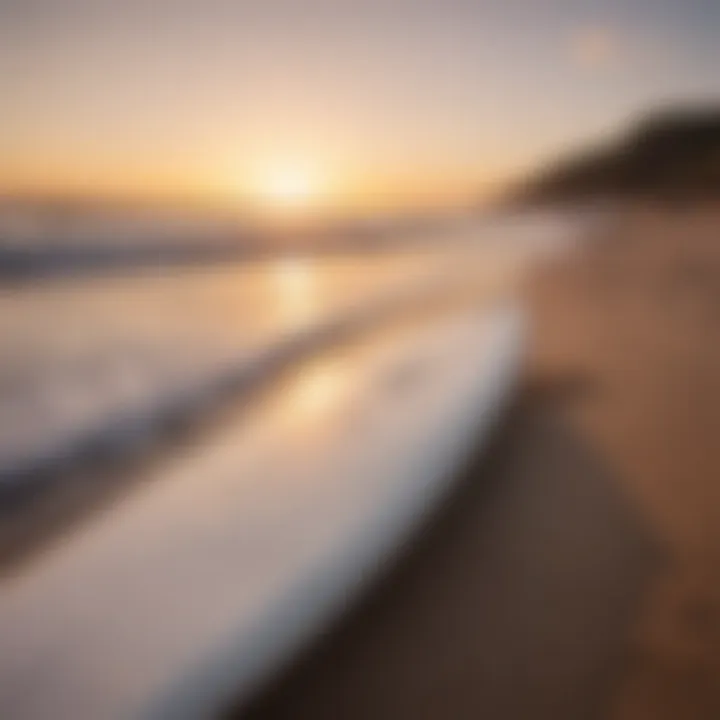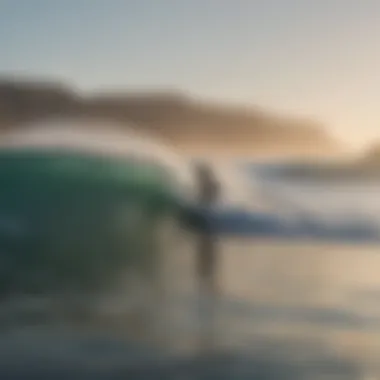Exploring the Depths of Dawn Patrol Surfing


Intro
Dawn patrol surfing is not just a recreational activity; it’s a ritual that transcends the mere act of riding waves. For many, it is a way to connect with the ocean when the world is still cloaked in silence. The gentle lapping of waves, the golden hues of the sun just beginning to break, and the crisp morning air create an atmosphere that is both tranquil and invigorating. In this section, we will dive into the core elements that define this unique practice, exploring its appeal and the nuances that set it apart from traditional surfing.
Surfers relish the dawn patrol for its quiet solitude, an escape from the chaos that binds many to their routines. The water is often less crowded, allowing for an intimate experience with nature. But beyond the peaceful ambiance, there are practical advantages—waves tend to be cleaner, and the winds lighter in the early hours. So, whether one is a seasoned surfer or just starting, dawn patrol offers something that can enhance one’s connection with the ocean.
The allure of dawn patrol isn’t just about the experience, though. It’s also about the community. Out there in the morning light, friendships are forged over shared rides and mutual respect for the ocean. Each session brings a sense of camaraderie, with local knowledge often shared among participants about tides, breaks, and best times to surf.
Through this article, we will cover everything you need to know about dawn patrol surfing—from the essential gear that makes your experience enjoyable, techniques that elevate your skills, to the atmospheric conditions that can make or break your session. Let’s begin this journey by exploring the vital gear essentials that every adventurer should consider.
Preamble to Dawn Patrol Surfing
Dawn patrol surfing is not just a practice; it’s an intimate ritual that draws surfers to the ocean before the world starts stirring. This part of the day is veiled in tranquility, offering not just waves but a unique opportunity for connection with nature. Engaging in dawn patrol means entering the ocean when most still linger in their beds. It’s in these early hours that the ambiance is serene, the air is crisp, and the promise of unblemished waves calls out to those with a thirst for adventure.
The importance of this topic rests heavily on several key elements. Firstly, it celebrates the quietude that only a few early risers get to experience. It’s a time when the waves are less touched by fellow surfers, giving a sense of ownership and solitude to each ride. Not to mention, the calm waters often lead to optimal wave conditions, making for an exhilarating experience.
Furthermore, engaging with dawn patrol surfing allows for mental clarity. As stressors of the everyday life fade into the background, surfers can focus entirely on their craft. This practice transcends just being a sport; it is a meditation. Hmm, isn't it lovely?
As we delve deeper into this nuanced aspect of surfing, there are considerations to keep in mind. From understanding tide patterns to preparing mental and physical readiness, dawn patrol serves as a multifaceted experience worthy of exploration.
Ultimately, this section lays the groundwork for everything that follows. It is a deep dive into what makes dawn patrol more than just a surfing session. It’s an art and a science, interwoven with the fabric of surfing culture that continues to evolve with each wave.
What is Dawn Patrol?
Dawn patrol is simply the act of surfing at the crack of dawn. For many, it’s a commitment that speaks volumes about a surfer’s dedication. Some wake up before the sun makes its appearance, making their way to the beach with sleepy eyes yet full hearts. This tradition suggests that the early bird really does catch the wave, engaging with the ocean when conditions are prime.
When folks chat about dawn patrol, it often refers to the whole experience: paddling out before daybreak, feeling the first rays of sun warm the cold morning air, and being greeted by the rhythmic sound of waves breaking. It’s like becoming a part of nature's early morning symphony.
Historical Context and Evolution
Tracing the roots of dawn patrol surfing reveals layers of history intertwined with surfing culture. This practice likely emerged from the surfing communities of the West Coast, particularly in places like California and Hawaii. In the earlier days, before the commercial surf industry truly took off, surfers often took to the water at dawn to ensure they could enjoy the waves before restrictions from other individuals began.
Over the years, dawn patrol has grown beyond a mere means to catch waves. It evolved into a cherished tradition, deeply embedded in the surfing lifestyle. The dawn patrol crews embraced this ritual as a way to bond, share, and invest in their craft while celebrating the ocean's prowess. A surfer may share tales around a campfire after an exhausting early morning session, highlighting the spiritual connections formed during these quiet hours.
Thus, understanding the historical context and the evolution of dawn patrol enriches one’s appreciation of the practice. From its humble beginnings to its prominent presence in surfer communities around the globe, dawn patrol surfing is a windows into the past, aptly demonstrating how the ocean can elicit a call that transcends time.
The Advantages of Dawn Patrol
Dawn patrol surfing offers a multitude of benefits that cater to both the physical and mental aspects of the sport. It’s not just about the thrill of catching waves; it’s about the entire experience that dawn patrol provides. From improved wave conditions to a peaceful atmosphere and enhancing one's mental clarity, each advantage plays a crucial role in this unique surfing ritual. Let’s delve into the key elements that make dawn patrol such an enticing choice for surfers and water sports enthusiasts alike.
Optimal Wave Conditions
When discussing dawn patrol, optimal wave conditions are often cited as one of the primary advantages. Early mornings tend to bring glassy, untroubled waters due to lighter winds and less human interference. The surface has not been disturbed by the hustle and bustle that often comes with the day; the ocean is in a rare state of tranquility. This results in more consistent and powerful waves that can be ridden for longer stretches.
For instance, many surfers report that the waves during these hours can feel faster and easier to catch. New surfers might find that it’s less daunting to battle the waves with fewer people around. This leads to an overall enhanced surfing experience, both technically and emotionally.
Avoiding Crowds
Another hallmark of dawn patrol is the blissful solitude that comes with it. As the sun slowly rises, most of the world is still asleep, which means the beaches are less crowded. For seasoned surfers, this lack of competition for the best waves allows for more personal space and the opportunity to focus on their skills. For beginners, it lessens the pressure of having to navigate around others.
Imagine paddling out to an empty lineup, feeling like the ocean is your own personal playground. This situation significantly reduces stress, enabling surfers to concentrate on their form, practice new tricks, or simply enjoy the rhythm of the waves without the constant presence of fellow surfers.
Mental Clarity and Focus
Engaging in dawn patrol also contributes positively to mental clarity and focus. The calmness of the morning and the beauty of a sunrise create an almost meditative environment, encouraging surfers to slow down and savor the moment. The physical activity of paddling out and riding waves stimulates endorphin release, which can elevate mood and enhance mental wellness.
In a fast-paced world, taking a step back to acknowledge the simple joys of surfing during the quiet hours helps foster a sense of connection – not just to the ocean, but also to oneself. The routine can serve as a personal ritual that prepares individuals for the challenges of the day ahead, setting a positive tone that lasts beyond the final ride.
"Taking the time to surf at dawn almost feels like a secret world – just you and the ocean. It's a refreshing way to start the day, both physically and mentally."
In summary, the advantages of dawn patrol surfing go beyond mere technical benefits. They encompass a holistic approach to the surf experience, integrating optimal conditions, serene surroundings, and mental well-being. Whether you’re a seasoned pro or just starting out, the morning surf can offer something unique that’s worth waking up for.
Preparing for Dawn Patrol


Preparing for dawn patrol surfing involves more than just rolling out of bed and grabbing your board; it’s an art that combines meticulous timing, gear selection, and mental readiness. Understanding these elements can significantly enhance your experience, making those serene morning sessions not just enjoyable, but also productive and safe. The hours before sunrise provide an opportunity to connect with the ocean in its most tranquil state, but being prepared is essential to maximize the advantages of this unique surfing experience.
Timing Your Session
The early bird catches the wave, and in the world of dawn patrol surfing, timing is everything. The optimal time to be at the beach varies according to the tides and the local sun rise. Experienced surfers often use tide charts and sunrise calculators to pinpoint the best moments to hit the water. It's not just about catching waves; it's also about the perfect balance between water conditions and your own availability.
Aiming to arrive about 30 minutes before the sun peeks over the horizon is commonly recommended, as this allows you to warm up and gauge the surf before paddling out. Plus, it gives you the chance to admire the stunning gradient of colors that light up the sky, a spectacle that can kick-start your day with a sense of gratitude and wonder.
Essential Gear and Equipment
When it comes to dawn patrol, not having the right gear can be the difference between a memorable session and a miserable one. You want to be prepared for anything the ocean might throw at you, and that starts with selecting the proper equipment.
Surfboard Selection
Choosing the right surfboard is a pivotal aspect of preparing for dawn patrol. The type of board should complement the wave conditions and your skill level. Beginners might benefit from a longer, wider board that offers stability and buoyancy, which makes catching waves easier. On the flip side, more experienced surfers may choose a shorter board for the best maneuverability in tricky waves.
A popular choice for all-level surfers looking to enjoy both stability and performance is the funboard. This style balances length and versatility, making it easier to navigate varying conditions while still allowing for some radical moves. Just remember, each surfboard has its own set of unique features that could affect your riding experience, be it the dimensions, rocker profile, or fin setup.
Wetsuits and Accessories
Depending on where you surf, a good wetsuit can vastly improve your comfort and performance during dawn patrol. A well-fitted wetsuit not only keeps you warm in chilly waters but also provides necessary buoyancy and flexibility. Look for wetsuits that offer a good balance of insulation and mobility, especially if you're planning to spend extended hours in the water.
Accessories like booties, gloves, and hoods can also play a role considering the cold, especially in winter months. These add-ons keep the cold at bay but may slightly restrict your maneuverability. However, many surfers find the trade-off worthwhile in order to stay in the water longer.
Safety Gear
Safety should always be at the forefront of your mind when preparing for dawn patrol surfing. Wearing a leash is non-negotiable; it helps prevent your board from becoming a hazard in case you wipe out. Some surfers choose to invest in impact vests, especially if they often surf in gnarly conditions. These provide an added layer of protection, minimizing the risk of injuries from unexpected falls.
Other safety features like surf helmets might seem excessive, but they are gaining traction among those who frequently tackle heavier waves. Making safety gear part of your dawn patrol routine ensures you're not just physically prepared but also mentally confident as you paddle out.
Physical and Mental Preparation
Surfers often underestimate the importance of physical and mental readiness before grabbing their boards. Physically, it's smart to do some light stretches to warm up your body; this helps prevent injuries and improves your overall performance. Think of it as prepping the engine before a long drive: if everything’s running smoothly, you’ll have a much better experience.
On the mental side, take a moment to focus on your intention for the session. Are you there to challenge yourself, or perhaps just to unwind? Setting your mindset can help you navigate the waves, making your sessions more fulfilling. This mental clarity is especially advantageous during the peaceful yet heightened atmosphere of dawn patrol.
"Dawn patrol isn’t just about catching waves; it’s about connecting with nature at its finest, all while preparing yourself both physically and mentally for the day ahead."
By fine-tuning your preparation routine, you not only enhance your skill as a surfer but also enrich your overall experience within the surf community.
Navigating Environmental Conditions
Navigating environmental conditions is a cornerstone of mastering dawn patrol surfing. To partake in this early morning ritual, surfers must develop a keen awareness of how elements like tide, weather, and wave dynamics impact their experience. Understanding these factors not only enhances safety but also can significantly elevate the quality of your waves. This section dives deep into these three crucial components that every surfer should consider when planning their dawn patrol sessions.
Understanding Tide Patterns
Tide patterns are essentially the rising and falling of sea levels influenced by gravitational forces. Understanding these patterns can help surfers anticipate wave quality and where to catch them. A few key points to keep in mind include:
- High Tide vs. Low Tide: During high tide, water levels can rise rapidly, sometimes making the waves less steep and harder to catch. Conversely, low tide often provides better opportunities for stronger waves as they break more directly on the shore.
- Tide Times: It’s key to know the tide times in your area. Many surfers consult tide charts to determine when the best surfing conditions will arise. For instance, many beach-goers prefer to surf an hour before high tide and an hour after.
- Tide Swells: Some locations enjoy unique swell patterns depending on tide levels. Observing how tides interact with underwater topography can lead to finding those prime spots for ideal take-off.
Assessing Weather Conditions
Weather can feel like a fickle friend when it comes to surfing. Awareness of weather conditions can reveal hidden gems or hazardous scenarios during your dawn patrol. Here’s what to watch:
- Wind Direction: Offshore winds can lead to cleaner, more organized waves compared to onshore winds, which can create choppy conditions. Tracking wind patterns, especially early in the morning, is crucial.
- Temperature and Clothing: The air temperature can dictate your choice of wetsuit. Cold air can chill your body quickly after a surf session, while overly warm mornings might mean a thinner suit is necessary.
- Storms and Big Swells: Keep an eye on approaching storms, whether they be local or distant. A storm can lead to massive swells, offering thrilling rides or the perilous experience of dangerous waves.
Wave Dynamics and Their Implications
Being in tune with wave dynamics is like knowing the heart of the ocean. Certain factors determine how waves break and what kind of rides you can expect. Here are several considerations:
- Break Type: Knowing the type of breaks—beach, reef, or point—is essential for gauging waves ahead of time. Each offers distinct conditions significantly affecting ride quality.
- Local Knowledge: Gain insights from local surfers or resources like forums on reddit.com or surf reports. Understanding wave cycles, including how tides affect waves can lead to spotting perfect opportunities.
- Surf Forecasts: Websites like Windy or Surfline give detailed forecasts including swell size, period, and direction. Paying attention to these reports can align expectations with real-time conditions.
"A successful dawn patrol is not just about catching waves; it's about syncing with nature's rhythm, understanding the tide's pulse and feeling the wind's direction."
By grasping these environmental conditions, surfers can substantially improve their dawn patrol experiences. Each session becomes more efficient and focused, allowing one to make the most of every wave captured before the world stirs awake. Remember, it’s all about reading the signs the ocean provides, and with practice, this intuition can become second nature.


Techniques for Successful Dawn Patrols
The early morning surf session is often where the heart and soul of dawn patrol surfing lies, and having the right techniques in place can make all the difference. Mastering these essential skills ensures that surfers are equipped not only to catch more waves but also to enjoy their time on the water while facing the unique challenges that dawn sessions present.
Paddling Techniques for Early Mornings
Paddling in the morning can feel like a different game altogether. The water is typically cooler, which can catch you off guard if you're not prepared. Good paddling technique is paramount, especially during the dawn patrol. It's about finding that sweet spot between power and efficiency, as fatigue can quickly set in with the added chill in the air.
- Body Positioning: Sit slightly forward on your board to maintain balance while you paddle.
- Paddle Strokes: Use long, sweeping strokes that pull water without splashing excessively. It conserves energy and lets you glide smoothly over the waves.
- Core Engagement: Initiate each stroke from the core rather than relying solely on your arms to push through the water. This will give you more power and help you avoid unnecessary strain.
The ability to paddle efficiently will allow you to catch waves more easily during those early hours when the conditions are optimal.
Timing Your Take-Off
Timing is everything when catching waves at dawn. The conditions often change the moment the sun starts peeking over the horizon, making it essential to be in tune with the rhythm of the ocean.
- Reading the Swell: Watch how waves break and identify the right moment to take off. This requires patience and observation.
- Positioning Yourself: Ensure you're situated in the right spot to maximize your take-off chance. Some surfers prefer to paddle further out while others might stay closer to the shore, depending on the wave dynamics.
- Controlled Entry: When you feel the wave approaching, commit to a clean take-off by paddling vigorously to match the wave's speed. Stay relaxed, and focus on your stance as you rise to your feet.
Success hinges on understanding the way waves form and the moment they start peaking. It’s an art that comes with practice and familiarity with specific surf spots.
Riding Different Types of Waves
Each type of wave provides a unique riding experience, and understanding how to navigate different ones can enhance your dawn patrol experience significantly.
- Beach Breaks: Often more forgiving for beginners, but can shift due to sandbars and tidal changes. Look for consistent peaks and be ready to change directions quickly.
- Point Breaks: These offer longer rides and can carry a surfer along for a decent distance. Understand where the wave will break, and position accordingly.
- Reef Breaks: Typically more advanced; these often require precise positioning and timing as the wave can break hard over rocky surfaces. If you choose to ride these waves, be aware of the additional hazards present.
Each wave type demands a different strategy and technique. Learning to adapt doesn't just improve your skills; it enriches the entire dawn patrol surf experience.
"The dawn patrol is not just about waking up early. It's about tuning in with nature and catching those fleeting moments before the world comes alive."
The Social Aspects of Dawn Patrol Surfing
Dawn patrol surfing isn't just about chasing waves; it's also about personal connections and a shared passion among enthusiasts. Taking to the water in the early hours creates unique social landscapes that nurture both friendships and community spirit, binding individuals through familiar experiences. The heady mixture of adrenaline, tranquility, and camaraderie fosters an environment that many surfers cherish. While the waves can be solitary moments of reflection, the surf culture thrives on the community of surfers who gather to enjoy the sport together.
Building Community
At dawn, when the sun is just peeking over the horizon, surfers often find themselves among a small group of like-minded individuals. This tight-knit atmosphere creates an instant bond that is not simply about riding waves. Those who paddle out together frequently cultivate friendships that transcend the water.
Taking part in dawn patrol can lead to regular meet-ups; this routine collections not only strengthens friendships but also creates networks where surfers share tips on gear, technique, and local wave conditions.
The act of sharing the ocean — as the first light breaks — has a way of solidifying a sense of belonging. Every session becomes a mini event, where stories are exchanged, and new skills are learned. As a surfer, participating in a dawn patrol may just mean joining a communal journey every morning, making the day’s adventure all the more enriching. It’s not merely about the thrill of the waves; it’s about returning to the same local spot, building the narrative together, and contributing to the lore of your surfing tribe.
Sharing Experiences
The morning surf sessions are fertile ground for storytelling and sharing experiences. Imagine a group of surfers sharing tales of their most exhilarating rides or the time they wiped out spectacularly, drawing laughter and camaraderie from everyone present. This ritual allows for both learning and emotion, as more experienced surfers often take the time to mentor newcomers, sharing insights they've gained over the years.
Sharing experiences isn't limited to the surfboards, though. Online forums and social media platforms like Reddit and Facebook have amplified the conversations sparked at dawn. The stories and tips shared in-person often continue in the virtual world, where larger communities can interact.
"The ocean is a place that tells stories. When I catch a wave, I’m not just riding water, I’m riding a tale that binds us all together."
These moments, encapsulated in shared experiences, reinforce the idea that dawn patrol surfing creates more than just surfers; it yields a family linked by shared challenges and joys.
Dawn Patrol Culture
The culture surrounding dawn patrol has become a distinct subculture within the broader surf community. It embodies not just the act of surfing but a lifestyle steeped in respect for the ocean and community spirit. The culture encompasses early morning surf rituals, from the quiet moments spent preparing equipment to the exhilaration of catching that first wave as the sun breaks the horizon.
Many surfers find that this early practice is infused with a deeper appreciation for nature. With fewer disruptions from the outside world, the tranquility of dawn patrol promotes mindfulness. The golden hour serves as a backdrop where friendships begin to form and traditions solidify.
Various surfers embrace this culture, as it often involves respect for surf etiquette, ensuring everyone gets a chance to catch a wave while promoting safety. Engaging in dawn patrol is about balancing the excitement of the ride with the responsibilities to fellow surfers. As newcomers enter this world, they are often welcomed into a culture that values both respect and enjoyment.
Surfers who have experienced dawn patrol recognize it as a lifestyle choice that transcends just surfing; it carries with it a sense of belonging. It is not uncommon to spot a mix of surfboards on the roof racks of cars, each representing unique stories waiting to unfold.
In short, the social aspects of dawn patrol surfing extend far beyond the physical act of riding waves. They encompass a vibrant community, shared experiences, and a culture that intertwines the deep love for surfing with respect for nature and relationships, making every dawn patrol session not just an activity, but a cherished experience.
Safety Concerns and Best Practices


When it comes to dawn patrol surfing, being aware of safety concerns is just as important as catching that perfect wave. Early mornings can be tranquil, but they also bring unique risks that surfers must face. Understanding these safety issues not only protects you but also enhances your overall surf experience.
Awareness of Hazards
Surfing at dawn presents several hazards that can catch even seasoned surfers off guard. The low light conditions can hinder visibility, making it difficult to see obstacles under the water or other surfers paddling nearby. A few hazards include:
- Riptides and Currents: These can be tricky to spot in low light. Riptides are often invisible, and they can pull you away from the shore much faster than you might expect. It's essential to recognize local tidal patterns and to check tide charts before heading out.
- Marine Life: Some areas might have early morning marine activity that could pose risks. Encounters with jellyfish or other sea creatures are more likely when you’re out at dawn, so have your eyes peeled.
- Surf Breaks: The shape and contours of waves can change depending on the tide, so knowing your surf spot is paramount. A wave that breaks normally may act differently in the morning hours.
Awareness of these hazards can significantly reduce risks when you're out at sea. Be sure to scout your spot ahead of time and ask locals about any potential dangers.
Buddy System and Communication
In many outdoor activities, a buddy system is a dependable approach, and dawn patrol surfing is no exception. Surfing alone early in the morning can be risky, especially in unfamiliar waters. A buddy can help watch your back and can be particularly useful in cases of sudden changes in weather or unforeseen accidents.
Effective communication between surfing partners is key. Inform your buddy:
- Your planned route: Share where you intend to surf and discuss any possible hazards.
- Safety signals: Establish hand signals or whistles to convey essential messages when you're in the water, especially if you’re far apart.
Additionally, keep your phone handy if it’s safe to do so. While you shouldn't depend entirely on it, in case of emergencies, having a charged phone could save crucial time.
Emergency Protocols
No one likes to think about emergencies, but having a plan in place can make a world of difference. Prepare for possible scenarios:
- Recognizing Signs of Distress: Be aware of the signs that someone may be in trouble, such as struggling to paddle or a surfer who has not resurfaced after a wipeout.
- Rescue Techniques: Familiarize yourself with basic rescue techniques. Know how to approach a struggling swimmer and methods for getting them safely to shore.
- First Aid Knowledge: It's beneficial to learn first aid basics and carry a small first aid kit. Understanding how to treat lacerations or bites, and knowing where to find help nearby are good practices.
- Local Emergency Numbers: Before heading out, have important numbers saved on your phone, including local emergency services, lifeguard stations, and a trusted friend who can assist if you don't return at an expected time.
"Safety isn't just a word for surfers; it's a motto to live by. Being prepared is being smart."
By embracing these safety concerns and best practices, you not only protect yourself but also contribute to a more secure surfing environment for everyone. Dawn patrol surfing is meant to be enjoyed—take the time to prepare, communicate, and practice safety. It will yield a richer and more rewarding experience in the water.
Environmental Impact and Stewardship
Dawn patrol surfing is not just a pursuit of personal thrill; it intertwines with the broader tapestry of environmental impact and stewardship. As surfers glide over waves in the early morning mist, there’s a critical dialogue happening beneath the surface about preserving our oceans and coastlines. The practice of dawn patrol brings about a natural awareness of the delicate ecosystems we engage with.
When surfers immerse themselves in the ocean, they witness firsthand the beauty and fragility of marine environments. This connection fosters a sense of responsibility; after all, the ocean is not merely a playground but a vital resource that demands respect and care.
Sustainable Practices in Surfing
Adopting sustainable practices in surfing can make a notable difference. Here's how:
- Eco-friendly Surfboard Materials: Many surfboard manufacturers are now opting for sustainable materials, reducing reliance on petroleum-based products. Epoxy or recycled polystyrene options emerge as viable alternatives that do less harm to our oceans.
- Reusable Water Bottles: Staying hydrated is key during your dawn patrol, but why not bring along a reusable water bottle? This cuts down on plastic waste that often ends up polluting beaches and oceans.
- Participating in Beach Clean-ups: Joining local initiatives, where surfers come together to clean up beaches, not only keeps the surf spots pristine but also strengthens community ties.
Making a commitment to sustainable choices reflects a surfer's deep respect for both the waves and the ecosystem. Even small adjustments in our daily routines can add up to a significant positive impact.
Protecting Surfing Locations
Certain surf spots are renowned for their perfect waves and beautiful surroundings, but they are also susceptible to environmental threats. Here’s how surfers can help protect these precious locations:
- Advocating for Conservation Initiatives: Being part of or supporting organizations that focus on marine conservation can help maintain healthy surf environments. These groups often lead campaigns to safeguard coastal regions from overdevelopment and pollution.
- Respecting Wildlife: Surfers should be mindful of wildlife, especially during breeding seasons. Many marine animals have nests or habitats near popular surf spots, and awareness can prevent unwanted disturbances.
- Educating New Surfers: Sharing knowledge about the importance of preserving local surf spots can create a ripple effect. New surfers are often unaware of the ecological significance of the areas they enjoy, and education is a powerful tool for conservation.
"The wave is a gift from nature. Taking care of the ocean ensures we keep receiving them."
Through practicing awareness and action, the surfing community can be a strong voice in the preservation of the coastlines we cherish. As dawn patrol surfers, we must hold ourselves accountable. This stewardship not only enriches our experience but can also ensure that future generations continue to ride the waves we love.
End and Reflections
In drawing the curtain on our exploration of dawn patrol surfing, it becomes clear that this practice is more than just an early morning excursion to catch waves. It’s a holistic experience that intertwines elements of nature, community, and personal growth. When one reflects on the art and science of dawn patrol, several critical layers of meaning emerge that warrant a closer examination.
Personal Takeaways
For many surfers, the insights gained from dawn patrol sessions deeply resonate. The quiet of the early morning allows for an almost meditative state. It’s typically when considerations of daily life and the noise of the world fall away. Participants often report a heightened sense of clarity once they’ve paddled out to those lonely waters. It’s a moment where time feels elastic, stretching the boundaries of perception. The waves become not just part of a physical exercise, but an avenue to reconnect with one’s deeper self. The thrill of an unbroken wave often stirs a sense of accomplishment, akin to striking gold after a long search. When the sun crests the horizon, there’s an unspoken feeling of gratitude—both for the ocean and the personal journey each individual embarks on in this pursuit.
Encouragement for Newcomers
For those just thinking about stepping into the dawn patrol experience, it's essential to embrace the journey with an open heart and mind. Start by wading into the practice at your own pace. Begin by joining seasoned surfers; their familiarity with the ocean can provide invaluable insights. Don’t let fear of the early hours discourage you; instead, consider the possibility of witnessing nature’s beauty unfold right before your eyes, a reward that far outweighs the mild discomfort of rising before dawn. Get to know your gear well and familiarize yourself with local surf conditions—they are your allies. As difficult as it may seem at first, the sense of community and belonging that develops from shared experiences in the dawn patrol will foster a lifelong passion for surfing and a respect for the ocean.
As you embark upon this adventure, keep in mind that every wave caught at dawn is a step not just towards mastering surfing skills, but towards nurturing a profound appreciation for the world around you. So, don’t fret about making mistakes or missing a wave; focus instead on being present and soaking in the moment. This anticipation for the next dawn patrol is not just about the waves; it’s about the journey, the memories, and the growth that follows.
"Surfing, for many, is not a sport but an act of communion with nature, revealing not just the external ocean but the internal self as well."
In summation, the dawn patrol experience offers a unique tapestry woven with the threads of physical activity, mental fortitude, and emotional connection. It is a practice worth pursuing, inviting newcomers and seasoned pros alike to discover its numerous layers, each more rich and rewarding than the last.



